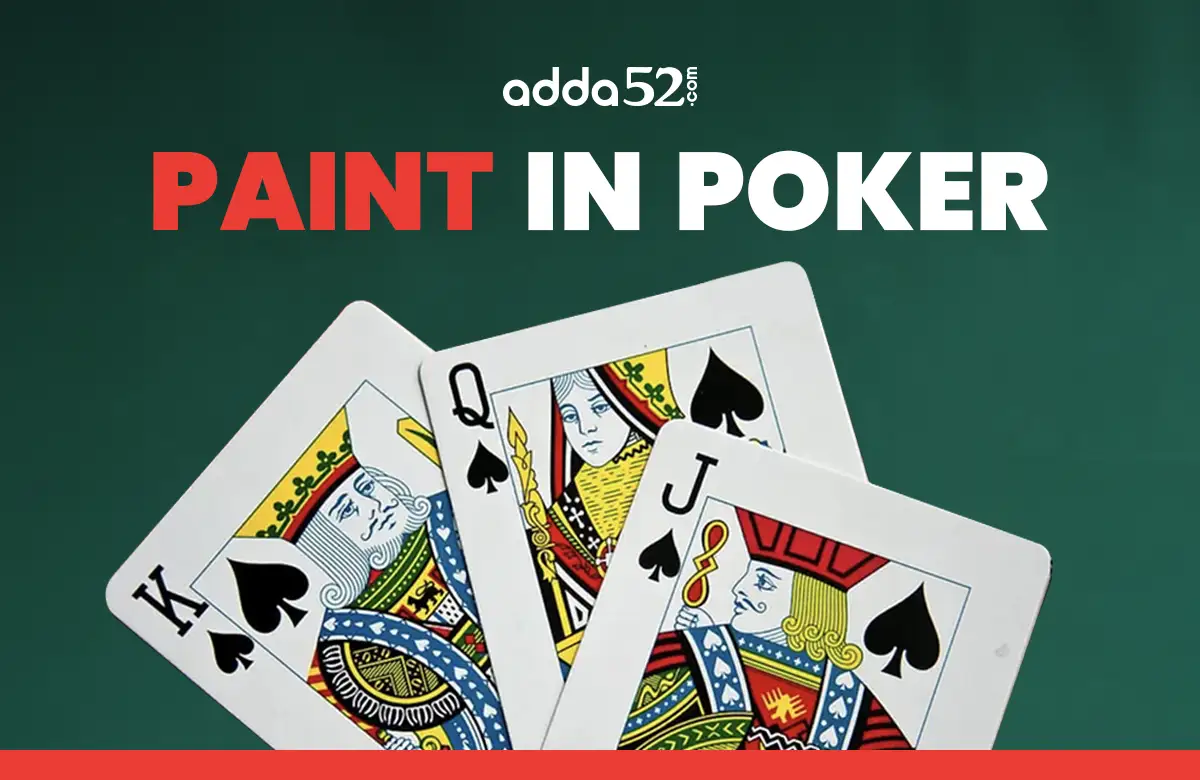
Introduction
Paint cards are the backbone of strong hands. They hold more value than the lower-numbered cards and offer a wider range of opportunities to form winning combinations like pairs, straights, or even a flush.
In this article, we will explore the role of paint cards in Poker.
Understanding Paint Cards
Paint cards, also known as face cards, refer to the King (K), Queen (Q), and Jack (J) in a deck. They are high-value because they can form strong hands.
How Paint Cards Influence Hand Strength
The presence of paint cards in your hand or on the board signals strength and potential for forming winning hands. Here's how:
- High-Ranking Cards: Paint cards are some of the highest-ranked cards in the deck (except the Ace). As such, they frequently form strong pairs or contribute to creating top-value hands.
- Forming Premium Hands: Paint cards are crucial in forming premium poker hands, such as top pairs (e.g., K-Q), straights (10-J-Q-K-A), and flushes when suited. They also frequently appear in strong pocket pairs like KK, QQ, and JJ.
- Crafting a Winning Strategy: Paint cards influence the game's pre- and post-flop phases. Preflop, these cards often guide a player’s betting decisions, especially when held in combination with other strong cards. Postflops, these cards affect betting patterns and the odds of winning.
Example:
- Holding K♠ Q♣ preflop in Texas Hold'em is a strong hand that can lead to top pairs, straight draws, or even a flush if the board cooperates.
How Poker Paint Cards Help in Forming Strong Hands
Paint cards frequently help form some of the most powerful Poker hands. Here’s how they contribute:
- Pairs: When you have a paint card in your hand, there's a chance that you will land a pair on the board. A pair of Kings (KK) or Queens (QQ) is a solid hand, often leading to strong positions in the game. Pairing one of your face cards on the board (like a King on a K-5-3 board) gives you a top pair and positions you to dominate weaker hands.
Example: You hold K♠ Q♣, and the flop is K♣ 8♥ 4♦. You have a top pair (Kings) with a strong kicker (Queen).
- Straights: Paint cards also help form high, straight hands. For example, a Broadway straight involves the cards 10, J, Q, K, and A. Having multiple paint cards in your hand can easily lead to this high-ranking straight if the board aligns.
Example: You hold Q♠ J♣, and the flop is 10♠ K♣ 3♠. You have a straight (10-J-Q-K-A).
- Flushes: When paint cards are suited, they have the potential to create flushes, which are stronger than pairs and straights. A hand like K♠ Q♠ has the potential to form a flush if the appropriate cards of the same suit appear on the board.
Example: You hold K♠ Q♠, and the flop comes 2♠ 6♠ 9♠. You now have a flush, which is a strong hand.
How to Play Poker Paint Cards Preflop
The pre-flop phase of a Poker hand is crucial, and paint cards can guide your decision-making. Depending on the position and situation on the table, paint cards can be powerful starting hands or hands to avoid.
- Premium Hands: Pocket Kings (KK), Queens (QQ), and Jacks (JJ) are generally played aggressively, especially in early positions. In No-Limit Texas Hold'em, these hands are often raised or reraised to build the pot and discourage opponents from entering the hand with weaker cards.
Example:
- KK: If you hold pocket Kings (K♦ K♠) and are in an early position, you should raise, possibly 3x or 4x, the big blind to assert dominance.
- Broadway Hands: Paint cards are also made for strong Broadway hands, like AK, KQ, AQ, and KJ. These hands can be very strong in late positions because you can see how your opponents act before you move. AK (Ace-King) is a particularly strong hand and often gets raised preflop regardless of position.
Example:
- KQ: If you hold K♠ Q♦ and are in the middle to late position, you can raise, aiming to take control of the pot.
- Speculative Hands: Hands like QJ, K10, or J9 can be speculative. These hands are less likely to dominate but can be played in late positions when the table is loose. Such hands often work best in pots with multiple players, giving you the potential to hit a straight, flush, or two-pair.
Example:
- K10 offsuit: This is a marginal hand you might raise from the cutoff or button position, especially if you are against weaker players.
How to Play Paint Cards Postflop
Once the community cards are dealt with, paint cards continue to play a major role in forming winning hands and shaping the game's flow. Their value is often tied to the strength of your post-flop hands, including top pairs, straights, and flushes.
- Top Pair and Top Kicker: When a paint card appears on the flop, it’s common for one player to make a top pair with a strong kicker. For example, holding KQ when the flop is K-7-3 gives you the top pair with the best possible kicker.
Example:
- You hold K♠ Q♠, and the flop comes K♣ 4♦ 2♥. You have a top pair (Kings) with a strong kicker (Queen).
- Draws: Paint cards are also important for straight or flush drawings. For example, if the board shows 10♠ 9♠ 2♦, and you hold J♠ Q♠, you have an open-ended straight draw and a backdoor flush possibility.
Example:
- You hold Q♠ J♠, and the flop comes 10♠ 9♦ 2♠. You have a straight and flush draw, giving you multiple ways to win.
- Missed Opportunities: Paint cards can leave you dominated by stronger hands. For example, holding QJ on a board with K-7-3 means you have a second pair and are losing to anyone holding K-x or better.
Bluffing and Semi-Bluffing with Paint Cards
Paint cards are often used as part of bluffing strategies due to their strong visual appeal. When you hold paint cards, it’s easier to represent a strong hand, especially when the board shows high cards.
- Bluffing: If the board has several paint cards (e.g., K-Q-4), you can bluff with cards like A10 or K10, representing a higher pair or straight.
Example:
- You hold A♠ 10♠, and the flop comes K♠ Q♦ 4♣. You can bluff, pretending to have a strong King, while you still have the possibility of a straight if an Ace or Jack comes on the turn or river.
- Semi-Bluffing: Semi-bluffing involves betting with a hand that may not be the best but can potentially improve. For example, holding QJ on a 10♦ 9♠ 3♣ board gives you an open-ended straight draw. You can semi-bluff by betting or raising to build the pot and put pressure on your opponents.
Frequently Asked Questions
What are paint cards in Poker?
Paint cards refer to the face cards in a deck: Kings (K), Queens (Q), and Jacks (J). They are called ‘paint’ because their faces are illustrated. These cards are highly valuable as they contribute to forming premium hands like pairs, straights, and flushes.
Are paint cards always strong in Poker?
Not always. Paint cards are strong in favourable situations, such as forming top pairs or straights. However, their strength depends on factors like position and opponents' actions. Overplaying weaker paint cards like QJ offsuit can lead to domination by stronger hands.
Are paint cards good for bluffing?
Yes, paint cards are effective for bluffing, especially on boards with high cards (e.g., K-Q-4). Semi-bluffs work well withdraws, like holding QJ on a 10-9-X board. Their high-value perception forces opponents to fold weaker hands.
Conclusion
Paint cards are a central part of Poker strategy and can heavily influence the outcome of a hand. However, understanding when to play aggressively, when to fold, and how to bluff with paint cards is essential to maximizing their value. Mastering the art of playing paint cards and adjusting your strategy based on the board and position can greatly enhance your Poker performance.
